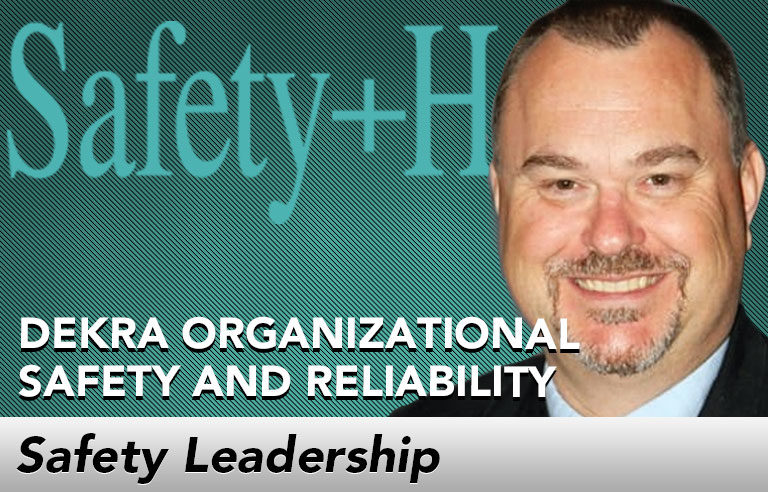Safety Leadership: Demonstrate your personal safety ethic

Editor’s Note: Achieving and sustaining an injury-free workplace demands strong leadership. In this monthly column, experts from global consulting firm DEKRA Organizational Safety and Reliability share their point of view on what leaders need to know to guide their organizations to safety excellence.
Saying you value safety in the workplace and demonstrating it are two very different things.
One challenge leaders often have is that although they may articulate that they understand why safety is important, it can be a struggle to show that safety is authentically part of “who they are.” In other words, they have difficulty showing that it’s rooted in their personal safety ethic.
This needs to change if their organization is committed to changing its safety culture. Having a personal safety ethic means that safety is actively seen by both their leadership peers and front-line workers as a part of their agenda, and that they have the conviction to carry it out. This value for safety is perceived as transcending the traditional business culture because it has been made a priority.
So, what is a “personal safety ethic,” anyway?
A leader’s personal safety ethic is demonstrated by every action taken and not taken when it comes to safety. It’s embodied several different ways:
- How safety is communicated verbally and in writing.
- The energy, emotion and body language he or she displays when discussing safety.
- The degree to which the leader conveys a personal responsibility for the safety of him or herself and others.
- The continuous effort to understand exposure and exposure reduction.
- The degree to which safety considerations are integrated into the decision-making process.
- The level of engagement with safety improvement initiatives.
All of these can be learned, but leaders with a strong personal safety ethic often have a firsthand story to tell about why safety is particularly important to them.
Often, it’s about a life-changing event that led to a reevaluation of their leadership role in creating a safer workplace. For example, in my career, I’ve seen leaders change after experiencing the loss of a team member while performing work. These leaders previously may have repeatedly stressed that safety was important, but their words didn’t always equal action.
When a personal safety ethic is strongest, action follows words and safety becomes internalized. This connection between commitment and action is critical if an organization wants to see improvements in safety, and it starts with creating – or strengthening – the personal safety ethic at the top.
Leaders who want to improve how they express their personal safety ethic should focus on these five areas:
- Developing more self-awareness – understanding their own natural tendencies and how these tendencies support or detract from their safety messages.
- Demonstrating empathy and being able to communicate that they understand a person’s situation or experience.
- Having contact and positive engagements with people and their individual safety experiences so that they have firsthand knowledge of the kinds of work situations that their team faces every day.
- Showing they take personal ownership and accountability for safety systems, culture and results. This means not blaming others for actions not taken. These are the kinds of moments when words turn into action.
- Understanding the ways in which their decisions and actions impact the level of risk exposure within the organization. Without this, a leader won’t be motivated to improve safety because safety will be viewed as something outside his or her influence and control.
Placing a premium on safety is a value organizations need to express, and it starts with top leadership.
The messages and follow-through that leaders express regarding safety go a long way in showing workers that leadership is “walking the walk” in minimizing exposures that could lead to injury or loss.
This commitment isn’t unique to any single industry, either. How leaders develop their personal safety ethic is the same no matter the workforce or region. By integrating safety as part of the overall culture, leaders will see positive results that go beyond the bottom line.
This article represents the views of the author and should not be construed as a National Safety Council endorsement.
 Steven Luttrull, vice president of DEKRA Organizational Safety and Reliability (dekra.us/osr), oversees complex, multisite and multiservice interventions for Fortune 500 clients in the metals, mining, petroleum, transportation and utilities industries.
Steven Luttrull, vice president of DEKRA Organizational Safety and Reliability (dekra.us/osr), oversees complex, multisite and multiservice interventions for Fortune 500 clients in the metals, mining, petroleum, transportation and utilities industries.
Direct to your inbox: Sign up to be notified in email about new "Safety Leadership" columns.
Post a comment to this article
Safety+Health welcomes comments that promote respectful dialogue. Please stay on topic. Comments that contain personal attacks, profanity or abusive language – or those aggressively promoting products or services – will be removed. We reserve the right to determine which comments violate our comment policy. (Anonymous comments are welcome; merely skip the “name” field in the comment box. An email address is required but will not be included with your comment.)

